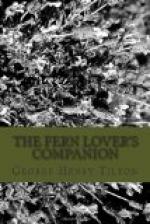F. incisum is a form in which the pinnae are much incised.
F. crispum has the edges of its pinnae crisped and ruffled. The name Christmas fern, due to John Robinson, of Salem, Mass., suggests its fitness for winter decoration. Its deep green and glossy fronds insure it a welcome at Christmas time. “Its mission is to cheer the winter months and enhance the beauty of the other ferns by contrast.” In transplanting, a generous mass of earth should be included and its roots should not be disturbed.
[Illustration: Christmas Fern. Polystichum acrostichoides]
[Illustration: Christmas Fern. Polystichum acrostichoides]
[Illustration: Christmas Fern. Polystichum acrostichoides Top, Forked Form; Bottom, Incised Form (Maine)]
(2) BRAUN’S HOLLY FERN
Polystichum Braunii. Aspidium aculeatum Braunii
Fronds thick, rigid, one to two feet long, spreading, lanceolate, tapering both ways, bipinnate. Pinnules ovate or oblong, truncate, nearly rectangular at the base, sharply toothed and covered beneath with chaff and hairs. Fruit-dots small and near the mid veins. Indusium orbicular, entire. Stipes chaffy with brown scales.
[Illustration: Braun’s Holly Fern. Polystichum Braunii (Willoughby Mountain, Vt.) (Herbarium of G.H.T.)]
This handsome fern is rather common in northern New England. We have collected it in the Willoughby Lake region, Vt., and it is found at Mt. Mansfield, Randolph, and elsewhere in that state; also at Gorham, N.H., and Fernald reports it as common in northern Maine. It also grows in the mountains of New York and Pennsylvania, and westward. It was formerly thought to be a variety of the prickly shield fern (P. aculeatum), which has a very wide range and numerous varieties. The fronds remain green through the winter but the stipes weaken and fall over.
(3) HOLLY FERN. Polystichum Lonchitis
Fronds linear-lanceolate, short-stalked and rigid, eight to fifteen inches long. Pinnae broadly lanceolate-falcate or the lowest triangular, strongly auricled on the upper side, densely spinulose-toothed. Sori midway between the margin and midrib.
[Illustration: Holly Fern. Polystichum Lonchitis (Nottawasaga, Canada, West, Right, Alaska, Left) (Herbarium of C.E. Davenport)]
The name holly fern suggests its resemblance to holly leaves with their bristle-tipped teeth. The specific name lonchitis (like a spear) refers to its sharp teeth. A northern species growing in rocky woods from Labrador to Alaska, and south to Niagara Falls, Lake Superior and westward. Its southern limits nearly coincide with the northern limits of the Christmas fern.
THE MARSH FERN TRIBE
Under this designation Clute has grouped three of the shield ferns, which have a close family resemblance, and has thus distinguished them from the wood ferns, which also belong to the shield fern family.




